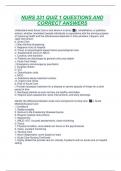NURS 331 QUIZ 1 QUESTIONS AND
CORRECT ANSWERS
Understand what Acute Care is and where it is done. ✅a. rehabilitative, or palliative
actions, whether orientated towards individuals or populations with the primary purpose
of improving health and the effectiveness depends on time-sensitive, frequent, and
rapid intervention
b. Acute Care
i. Often life/limb threatening
ii. Happens in/out of hospital
iii. Focus on physiological issues before psychological ones
iv. Assessments focus on ABC's
v. Curative, time-sensitive
vi. Patients are discharged to general units once stable
c. Acute Care Areas
i. Emergency and emergency psychiatric
ii. Surgical centers
iii. ICU
iv. Detoxification units
v. NICU
vi. Substance abuse treatment centers
vii. Urgent care clinics
d. Role of Acute Care
i. Provide necessary treatment for a disease or severe episode of illness for a short
period of time
ii. Discharge patients as soon as they are healthy and stable
iii. Require quick assessment, quick interventions, and early discharge
Identify the difference between acute care and general nursing care. ✅a. Acute
Medical/Surgical Care
i. Conditions
1. Stable/unstable
2. Serious to life-threatening illnesses/injuries
3. Require medical interventions
ii. Assessment
1. ABCD, H2T, focused assessments, close monitoring
iii. Focus
1. Physical condition, once stable can focus on the psychosocial
2. Close, constant monitoring
iv. Nursing Care
1. More independent, some based on team
v. Acute Care Nursing Continued
1. Highly skilled that provide care for critically ill patients with an acute care or hospital
setting
,2. Involves patients who have experienced severe illness or trauma, who require pre- or
post-op care, or other urgent medical conditions
3. Focus on improving health with rapid interventions under time sensitive conditions
b. General Medical/Surgical Care
i. Condition
1. Stable
2. Patients transferred from acute care
3. Minimal to no medical intervention
ii. Assessment
1. H2T, standard monitoring
iii. Focus
1. Health issue
iv. Nursing Care
1. Some independent, most based on team
Recognize the type of patient requiring acute care. ✅a. Patient acuity = the level of
patient care that is required based on the severity of a patient's illness or condition
b. Determining Acuity
i. ABCD
ii. H2T assessment
iii. Maslow's hierarchy of needs
1. Physiological basic needs
2. Psychological
3. Community
4. Self-actualization
c. Factors to consider
i. Actual, then potential problems
ii. Critical, then urgent problems, then routine
iii. Acute, then chronic conditions
iv. Unexpected, then expected outcomes
Understand the Physiological (Surgical) Stress Response ✅a. Stress = any physical or
psychological stimuli that disrupts homeostasis
b. Physiological Stress Response (PSR) = a pattern of physiological and pathological
changes that occurs in response to the prolonged stimulus of surgery, critical illness,
trauma, and/or burns
c. Allows for the body to adapt to life-threatening injuries
d. Provides adaptations to maintain vital functions while the body deals with the injury
e. The longer the body is out of homeostasis, the likelihood of survival from the injury
decreases (uses up resources)
f. Two Broad Categories of PSR
i. Neuroendocrine-metabolic response (1st)
ii. Inflammatory-immune response
g. The magnitude, invasiveness and duration of acute care determine the degree of the
body's stress response
, h. Body's attempt to maintain homeostasis during acute care induces adaptation
responses that lead to systemic inflammatory response syndrome (SIRS), hyper-
metabolism, and hyper-catabolism
i. Injury can lead to a loss of functioning negative-feedback systems causing...
i. Muscle wasting
ii. Impaired immune function (increased risk for infection)
iii. Impaired wound healing (resources are used up)
iv. Organ failure and death
Identify the Neuroendocrine-Metabolic and Inflammatory-Immune Responses to PSR
✅a. Neuroendocrine-Metabolic Response
i. Any stressor that overwhelms homeostasis will trigger the endocrine response
ii. Endocrine response
1. Corticotrophin-releasing hormone (CRH) stimulates hypothalamic-pituitary axis (HPA)
to release adrenocorticotropic hormone (ACTH), cortisol, growth hormone (hGH), and
ADH
a. All remain elevated for 7 days after initiation of PSR
2. Cortisol stimulates the SNS
3. SNS releases catecholamines in response to PSR Epi and NorE
a. Strengthens the SNS
i. Increased HR, SVR, SBP
ii. Strengthening muscles
iii. Decreased blood flow to stomach and kidneys
iv. Increased cellular metabolism and oxygen demand
v. Increased blood coagulability
b. Mobilizes carbohydrates and fat stores
i. Increasing hepatic and muscle lipolysis
ii. Increasing glycogenolysis hyperglycemia
b. Inflammatory-Immune Response
i. Excessive production of inflammatory mediators can cause a SIRS response
characterized by non-specific whole-body response
ii. Cytokines are responsible for mediating and maintaining the local inflammatory
response to tissue damage
iii. Cytokines help reduce the magnitude and duration of the SIRS response; if the
overall balance between the pro- and anti-inflammatory mediated response is
unregulated, immunodeficiency and sepsis are more likely
iv. Release of proteins in response to tissue injury and inflammation increased C-
reactive protein (CRP), fibrinogen, D-dimer, and fever
Identify factors that affect PSR. ✅a. Factors that Exacerbate PSR
i. Advanced age
1. Elderly patients have reduced muscle mass and are more prone to protein
catabolism, leading to worsening muscle wasting and fragility
2. Elderly patients have increases in plasma concentrations of coagulation factors
leading to increased risk of AMI, strokes, PEs, DVT
ii. Chronic disease




